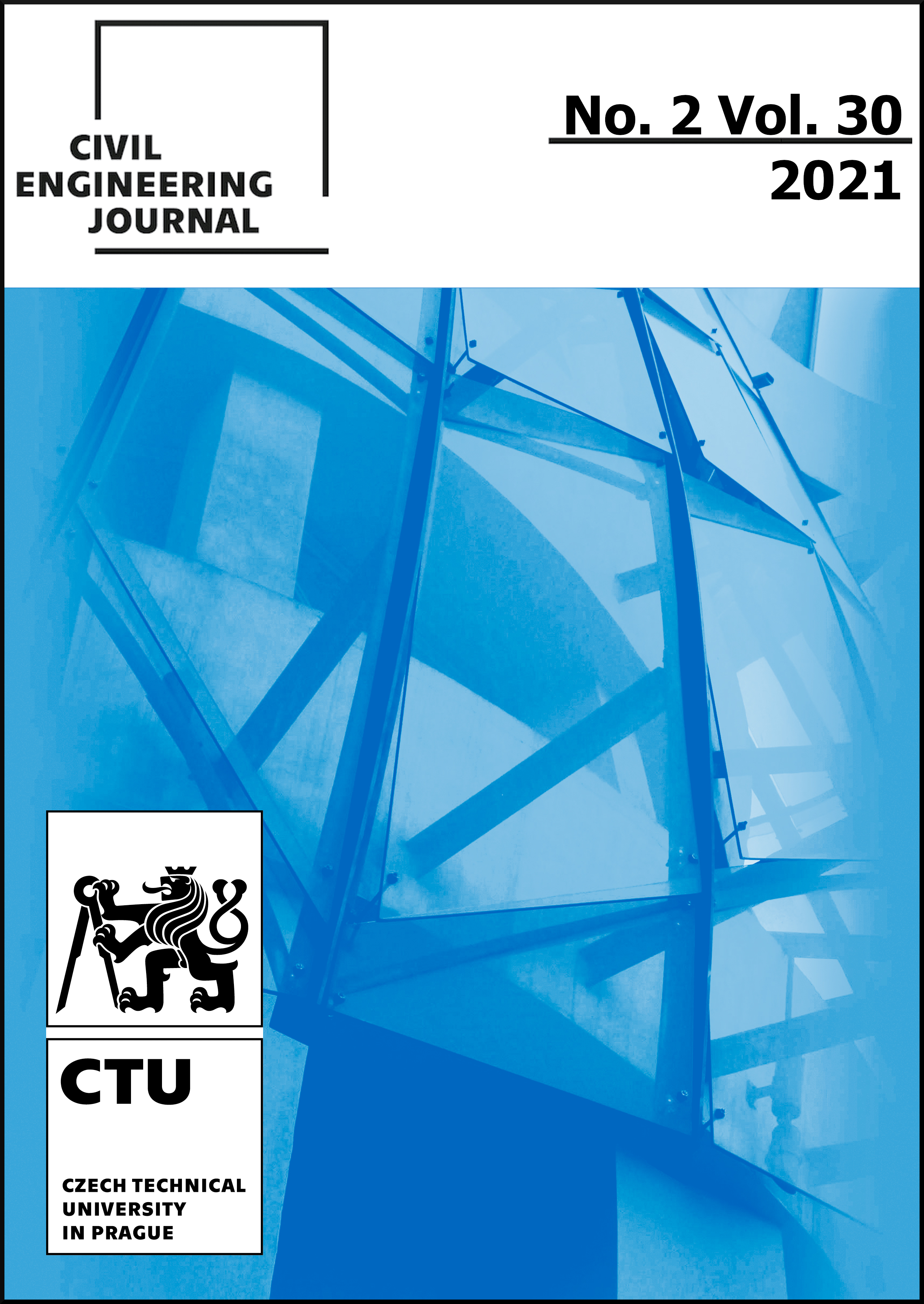EFFECT FACTORS’ SELECTION AND PREDICTION OF COMPRESSIVE STRENGTH OF SCC USING A HYBRID NETWORK BASED ON GA
DOI:
https://doi.org/10.14311/CEJ.2021.02.0031Keywords:
Self-compacting concrete, Artificial neural network, Genetic algorithm, Compressive strengthAbstract
Compressive strength is the most important evaluation index for concrete. In order to predict the compressive strength of self-compacting concrete, two kinds of artificial neural networks (ANNs), including the BP (Back-propagation) networks and the hybrid networks DRGA-BP based on GA (Genetic algorithm), were designed and applied in this study. With DRGA-BP, the most representative variables were selected out from many initial inputs to reduce data dimensions and also the weights and thresholds of BP model were optimized. The results showed that the hybrid model presented better prediction accuracy with the R2 (coefficient of determination) of 0.9602, and appeared to well agree with the experimental data and was quite reliable. Finally, a mix ratio design method based on DRGA-BP model was proposed for reducing material waste and saving time in the process of concrete production with continuous adjustment.
Downloads
References
Okamura, H.; Ouchi, M. Self-compacting concrete. J ADV CONCR TECHNOL 2003, 1 (1), 5-15.
Su, N.; Hsu, K. C.; Chai, H. W. A simple mix design method for self-compacting concrete. CEMENT CONCRETE RES 2001, 31, 1799-1807.
Han, L. H.; Yao, G. H.; Zhao, X. L. Tests and calculations for hollow structural steel (HSS) stub columns filled with self-consolidating concrete (SCC). J CONSTR STEEL RES 2005, 61 (9), 1241-1269.
Nikbin, I. M.; Beygi, M. H. A.; Kazemi, M. T.; Vaseghi Amiri, J.; Rahmani, E.; Rabbanifar, S.; Eslami, M. Effect of coarse aggregate volume on fracture behavior of self compacting concrete. CONSTR BUILD MATER 2014, 52, 137-145.
Gencel, O.; Brostow, W.; Datashvili, T.; Thedford, M. Workability and Mechanical Performance of Steel Fiber-Reinforced Self-Compacting Concrete with Fly Ash. COMPOS INTERFACE 2011, 18 (2), 169-184.
Domone, P. L. Self-compacting concrete: An analysis of 11 years of case studies. CEMENT CONCRETE COMP 2006, 28 (2), 197-208.
Erdem, H. Predicting the moment capacity of RC beams exposed to fire using ANNs. CONSTR BUILD MATER 2015, 101, 30-38.
Yeh, I. C. Modeling slump flow of concrete using second-order regressions and artificial neural networks. CEMENT CONCRETE COMP 2007, 29 (6), 474-480.
Astray, G.; Gullón, B.; Labidi, J.; Gullón, P. Comparison between developed models using response surface methodology (RSM) and artificial neural networks (ANNs) with the purpose to optimize oligosaccharide mixtures production from sugar beet pulp. IND CROP PROD 2016, 92, 290-299.
Lai, S.; Serra, M. Concrete strength prediction by means of neural network. CONSTR BUILD MATER 1997, 11(2), 93-98.
Yeh, I.-C. Design of high-performance concrete mixture using neural networks and nonlinear programming. Journal of Computing in Civil Engineering 1999, 13(1), 36-42.
Yeh, I. C. Computer-aided design for optimum concrete mixtures. CEMENT CONCRETE COMP 2007, 29 (3), 193-202.
Topçu, İ. B.; Sarıdemir, M. Prediction of properties of waste AAC aggregate concrete using artificial neural network. Computational Materials Science 2007, 41 (1), 117-125.
Oztaş, A.; Pala, M.; Ozbay, E. a.; Kanca, E. a.; Çagˇlar, N.; Bhatti, M. A. Predicting the compressive strength and slump of high strength concrete using neural network. CONSTR BUILD MATER 2006, 20 (9), 769-775.
Yeh, I.-C. Modeling of strength of high-performance concrete using artificial neural networks. CEMENT CONCRETE RES 1998, 28(12), 1797-1808.
Duan, Z. H.; Kou, S. C.; Poon, C. S. Prediction of compressive strength of recycled aggregate concrete using artificial neural networks. CONSTR BUILD MATER 2013, 40, 1200-1206.
Ghafari, E.; Bandarabadi, M.; Costa, H.; Júlio, E. Prediction of Fresh and Hardened State Properties of UHPC: Comparative Study of Statistical Mixture Design and an Artificial Neural Network Model. Journal of Materials in Civil Engineering 2015, 27 (11), 04015017.
Chithra, S.; Kumar, S. R. R. S.; Chinnaraju, K.; Alfin Ashmita, F. A comparative study on the compressive strength prediction models for High Performance Concrete containing nano silica and copper slag using regression analysis and Artificial Neural Networks. CONSTR BUILD MATER 2016, 114, 528-535.
Yu, W.; Li, B.; Jia, H.; Zhang, M.; Wang, D. Application of multi-objective genetic algorithm to optimize energy efficiency and thermal comfort in building design. Energy and Buildings 2015, 88, 135-143.
Nepomuceno, M. C. S.; Pereira-de-Oliveira, L. A.; Lopes, S. M. R. Methodology for the mix design of self-compacting concrete using different mineral additions in binary blends of powders. CONSTR BUILD MATER 2014, 64, 82-94.
Esmaeili, R.; Dashtbayazi, M. R. Modeling and optimization for microstructural properties of Al/SiC nanocomposite by artificial neural network and genetic algorithm. Expert Systems with Applications 2014, 41 (13), 5817-5831.
Prasad, B. K. R.; Eskandari, H.; Reddy, B. V. V. Prediction of compressive strength of SCC and HPC with high volume fly ash using ANN. CONSTR BUILD MATER 2009, 23 (1), 117-128.
Downloads
Published
Issue
Section
License
Copyright (c) 2021 Author

This work is licensed under a Creative Commons Attribution-NonCommercial 4.0 International License.
Authors who publish with this journal agree to the following terms:
- Authors retain copyright and grant the journal right of first publication with the work simultaneously licensed under a Creative Commons Attribution License that allows others to share the work with an acknowledgement of the work's authorship and initial publication in this journal.
- Authors are able to enter into separate, additional contractual arrangements for the non-exclusive distribution of the journal's published version of the work (e.g., post it to an institutional repository or publish it in a book), with an acknowledgement of its initial publication in this journal.
- Authors are permitted and encouraged to post their work online (e.g., in institutional repositories or on their website) prior to and during the submission process, as it can lead to productive exchanges, as well as earlier and greater citation of published work (See The Effect of Open Access).
How to Cite
Accepted 2021-07-20
Published 2021-07-28











